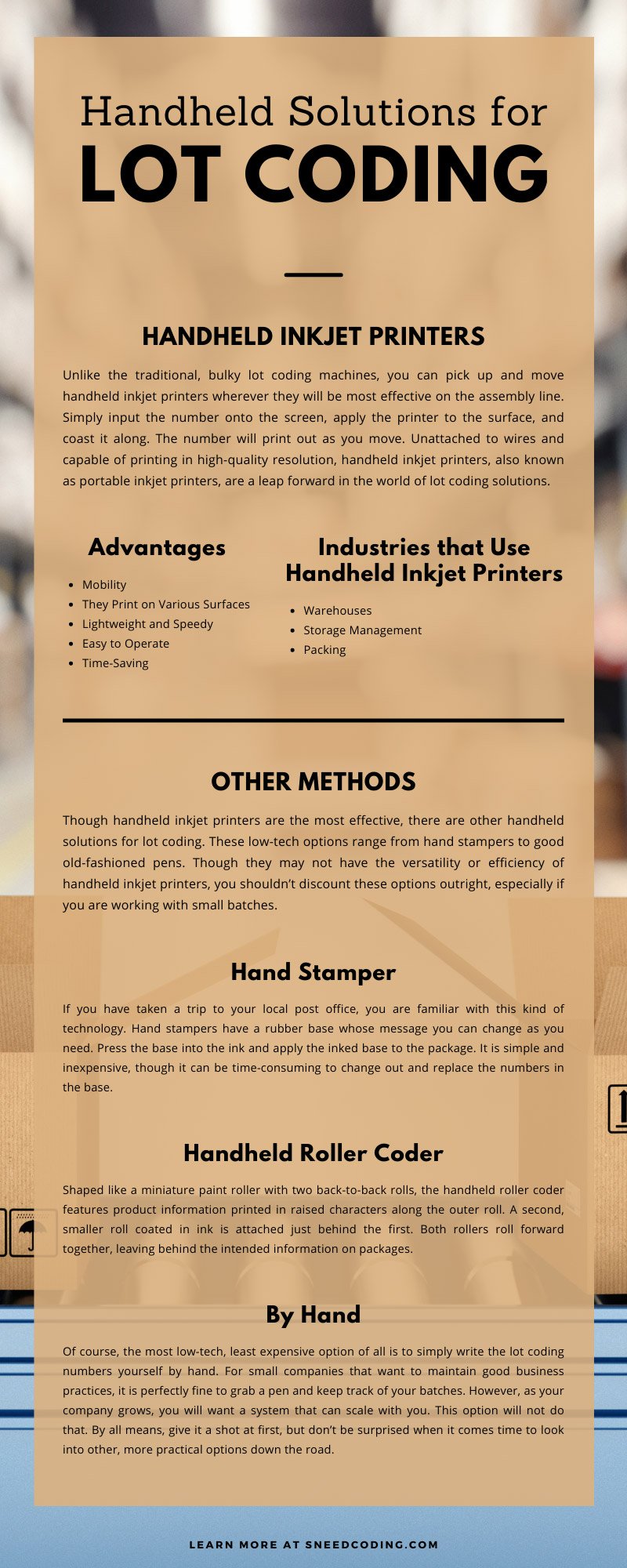
Though lot coding can feel like an overbearing chore that companies must put up with, now is actually an exciting time to get more involved with the subject. With the advent of handheld solutions for lot coding, we can print faster and more conveniently than ever before. While traditional printers are bulky and full of wires, these handheld solutions are portable and easy to use. Though this article will focus primarily on handheld inkjet printers, all the options have advantages that are well worth your consideration.
Handheld Inkjet Printers
Unlike the traditional, bulky lot coding machines, you can pick up and move handheld inkjet printers wherever they will be most effective on the assembly line. Simply input the number onto the screen, apply the printer to the surface, and coast it along. The number will print out as you move. Unattached to wires and capable of printing in high-quality resolution, handheld inkjet printers, also known as portable inkjet printers, are a leap forward in the world of lot coding solutions.
Advantages
- Mobility:
The foremost advantage of handheld inkjet printers is their mobility. With as much exertion as it takes to walk across an assembly line floor, you can bring these machines to batches whenever it is time to apply their numbers. Compare this to the effort it takes to use a traditional machine, and there is no question which is the easier option.
- They Print on Various Surfaces:
Handheld inkjet printers are easy to apply to a great variety of surfaces. This rugged device works on materials as diverse as:
- Concrete
- Plastic
- Paper
- Wood
- Glass
- Metal
- Lightweight and Speedy:
Portable and lightweight, you can store these devices for safety in a suitcase or a backpack. Even during bulk processing, when a person is likely to be holding the device for a long time, the weight on their arm will be minimal, allowing for a consistent output.
Aside from energy, the speed of the device will also save time. Advancements in technology have allowed for incredible speed in current handheld inkjet printers. Using the machine’s interface, you can make changes in just a couple of seconds.
- Easy to Operate:
Traditional inkjet printers are complicated to manage—not to mention labor-intensive. Trained personnel are necessary on-site to maintain consistency. But handheld inkjet printers take almost no time to learn and are simple to use.
- Time-Saving:
You will be surprised by the multiple ways handheld inkjet printers can save time. Not only are they quicker to use than traditional printers, but they also require little to no training time. Hours that you would have spent explaining to employees how to manage a piece of machinery can instead go into areas of the business that more directly generate revenue.
Industries that Use Handheld Inkjet Printers
- Warehouses
Handheld inkjet printers have a place in any industry where items make their way down an assembly line. Industries that create large batches of products and store them in warehouses need a way to look after their packages for recall purposes after they send them out into the world. That is where handheld inkjet printers come in handy. With little effort, you can sort batches into lot numbers and prepare to ship them out.
- Storage Management
If you store a great number of products, management can still benefit from the organization of grouping them by lot numbers in a warehouse. Portable inkjet printers work well in these settings because you can move them around to the difficult, hard-to-reach locations of a storage area.
- Packing
Many packing companies have used handheld inkjet printers to great success. As an industry under the vast umbrella of fast-moving consumer goods, packing requires QR codes, manufacturing details, labels, etc. And you can provide all of these with a handheld inkjet printer.
Other Methods
Though handheld inkjet printers are the most effective, there are other handheld solutions for lot coding. These low-tech options range from hand stampers to good old-fashioned pens. Though they may not have the versatility or efficiency of handheld inkjet printers, you shouldn’t discount these options outright, especially if you are working with small batches.
- Hand Stamper
If you have taken a trip to your local post office, you are familiar with this kind of technology. Hand stampers have a rubber base whose message you can change as you need. Press the base into the ink and apply the inked base to the package. It is simple and inexpensive, though it can be time-consuming to change out and replace the numbers in the base.
- Handheld Roller Coder
Shaped like a miniature paint roller with two back-to-back rolls, the handheld roller coder features product information printed in raised characters along the outer roll. A second, smaller roll coated in ink is attached just behind the first. Both rollers roll forward together, leaving behind the intended information on packages.
- By Hand
Of course, the most low-tech, least expensive option of all is to simply write the lot coding numbers yourself by hand. For small companies that want to maintain good business practices, it is perfectly fine to grab a pen and keep track of your batches. However, as your company grows, you will want a system that can scale with you. This option will not do that. By all means, give it a shot at first, but don’t be surprised when it comes time to look into other, more practical options down the road.
Summation
The handheld printer has forever altered our expectations of lot coding’s speed and efficiency. Other options, like the handheld roller or the hand stamper, have their benefits. But it is clear which of these is truly changing the game.
As your business scales upward and your lot coding needs become more complicated, be sure to consider how you can maximize and streamline your system. Your solution might be in the handheld inkjet printer, the stamper, the roller, the pen, or none of these options at all. Regardless, we hope that this article has given you some idea of this world’s layout and possibilities. As you move forward, you will be able to make better decisions for your business regarding lot coding.



